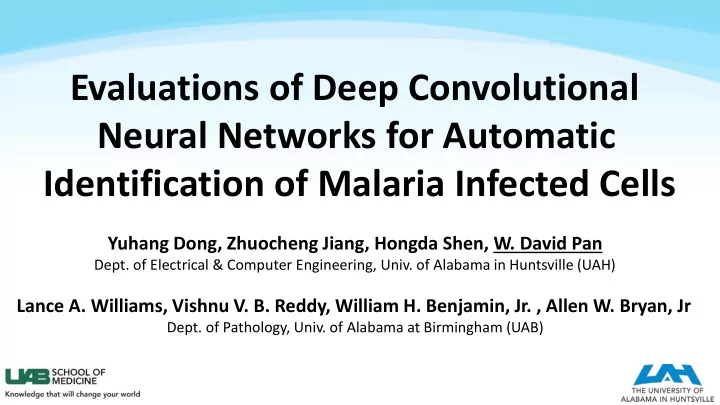

Evaluations of Deep Convolutional Neural Networks for Automatic Identification of Malaria Infected Cells Yuhang Dong, Zhuocheng Jiang, Hongda Shen, W. David Pan Dept. of Electrical & Computer Engineering, Univ. of Alabama in Huntsville (UAH) Lance A. Williams, Vishnu V. B. Reddy, William H. Benjamin, Jr. , Allen W. Bryan, Jr Dept. of Pathology, Univ. of Alabama at Birmingham (UAB)
• Problem Statement • Machine Learning for Automated Classification of Malaria Infected Cells • Wholeslide Images • Dataset of Cell Images for Malaria Infection • Deep Convolutional Neural Networks • Evaluation Results and Case Study • Conclusion
Problem Statement • 214 million malaria cases, causing 438,000 death in 2015 (source: WHO) • Reliable malaria diagnoses require necessary training / specialized human resources • Unfortunately, in many malaria-predominant areas, such resources are inadequate and frequently unavailable • Whole slide imaging (WSI): • Scans conventional glass slides • Produces high-resolution digital slides • The most recent pathology imaging modality, available worldwide • WSI images allow for highly-accurate automated identification of malaria infected cells.
Machine Learning for Malaria Detection • Machine learning algorithms have been shown to be very capable for building automated diagnostic systems for malaria. • Classification accuracy of feature-based supervised learning methods: • 84% (SVM) • 83.5% (Naïve Bayes Classifier) • 85% (Three-layer Neural Network) • Deep learning methods: • can extract hierarchical representation of the data • higher layers represent increasingly abstract concepts • higher layers become invariant to transformations and scales • NO publicly available high-resolution datasets to train and test deep Red blood neural networks for malaria detection – need to build one! cell samples • Plan: to evaluate several well-known deep convolution neural networks using a high-resolution dataset.
Wholeslide Images of Malaria Infection Image of 258 × 258 with Entire slide with cropped region 100X magnification delineated in green Whole Slide Image for malaria infected red blood cells from UAB
Compilation of a Pathologist Curated Dataset • Single-cell image extraction: • Apply image morphological operations • Dataset curation: • Four UAB experienced pathologists • Each single-cell image scored by at least two pathologists • To include an image in “infected” set, all reviewers must mark positively (excluded otherwise). • Similarly, to be “non - infected”, all reviewers must mark negatively. • Final dataset: • 1,034 infected cells Link to the dataset • 1,531 non-infected cells
Three Convolutional NN’s to be Evaluated CNN LeNet-5 AlexNet GoogLeNet Year Proposed 1998 2012 2014 # of Layers 4 8 22 Top 5 Errors on ILSVRC ? 16.4% 6.7% # of Convolutional Layers 3 5 21 Convolutional Kernel Size 5 11, 5, 3 7, 1, 3, 5 # of Fully Connected Layers 1 3 1 # of Parameters 3,628,072 20,176,258 5,975,602 Dropout No Yes Yes Data Augmentation No Yes Yes Inception No No Yes Local Response Normalization No Yes Yes
Training and Verification of CNN’s Label Training Testing Infected 517 517 Normal 765 766 Note: 25% of the training set used for verification. • The dataset is still too small. • Overfitting issue. • LeNet-5 has no drop-out.
Evaluation Results Ground Truth Positive Negative Accuracy Positive 493 25 LeNet-5 96.18% Negative 24 741 SVM Features : Positive 502 39 ranked from high to low AlexNet 95.79% Negative 15 727 • Hu’s moment 7,5,3,6 Positive 503 10 GoogLeNet 98.13% • MinIntensity Negative 14 756 • Shannon’s Entropy Positive 500 90 • Hu’s moment 2 SVM 91.66% See reference below. Negative 17 676 V. Muralidharan , Y. Dong, and W. D. Pan, “A comparison of feature selection methods for machine learning based automatic malarial cell recognition in wholeslide images,” IEEE BHI-16 .
Computational Aspect • SVM involves feature selection and feature extraction. • Three CNN running times (in seconds): CNN LeNet-5 AlexNet GoogLeNet Training- 7 28 141 Validation Testing 5 5 19 More parameters means longer training and testing time.
Features Learned (LeNet-5) Convolutional Layer 1 and Histogram
Features Learned (LeNet-5) Convolutional Layer 2 and Histogram
Conclusion Advantage of using CNN: • About 98% accuracy achieved with GoogleNet, significantly higher than SVM. • Tradeoff between computational complexity and accuracy. • Deep learning methods allow features to be automatically extracted, which is not possible with traditional methods. Further Work: • Build a larger dataset for the study, with the goal of achieving reliable and accurate automated malaria diagnosis.
Thanks!
Recommend
More recommend